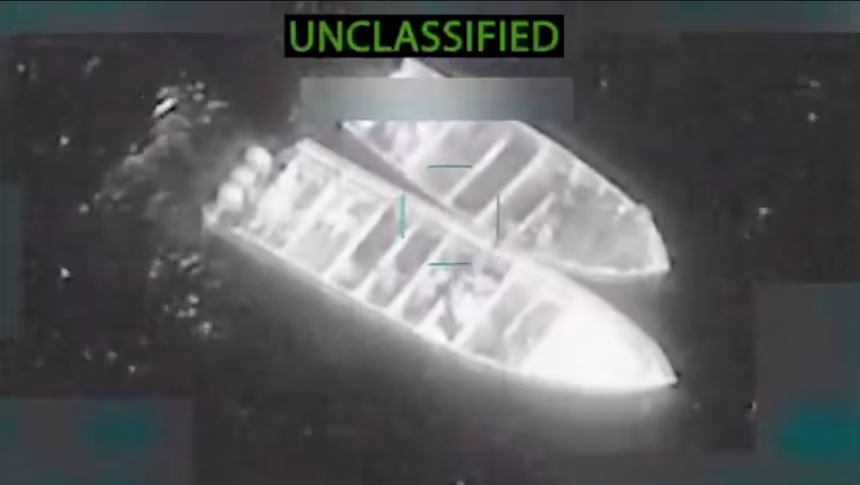In a rapid escalation of the Trump administration’s force-forward approach to transnational narcotics operations, the U.S. military conducted a series of deadly strikes on alleged drug-smuggling vessels in the eastern Pacific Ocean on Monday. According to Defense Secretary Pete Hegseth, four boats were destroyed during the operations, leaving 14 people dead and one survivor still unaccounted for by American authorities.
The strikes mark the first time multiple lethal interdictions have been launched on the same day in the Pacific theater as part of this evolving campaign. Since September, the Pentagon has increasingly relied on precision strikes to target what officials describe as “narco-terrorist” activity at sea.
Speaking publicly through the social platform X, Hegseth confirmed that Mexican authorities are now overseeing search and rescue efforts for the lone survivor. Officials in Mexico, however, have yet to issue any public statements on the matter, adding to the opacity shrouding these operations.
Surging Maritime Operations
Monday’s actions bring the total number of publicly acknowledged U.S. strikes against suspected narcotics vessels to thirteen since early September. In total, 14 boats have been destroyed, resulting in 57 fatalities and only three known survivors. Pentagon officials say all strikes occurred in international waters, without posing risk to U.S. personnel.
What concerns observers is the rapid expansion of these operations beyond the Caribbean Sea. Until last week, all known strikes targeted maritime corridors stretching between South America, Central America, and Caribbean island territory. The appearance of coordinated strikes in the eastern Pacific suggests an operational widening — possibly indicating new intelligence cues about trafficking routes or cartel strategies.
Contact With Survivors Raises Legal Questions
Although most individuals aboard these vessels have reportedly died during strikes, recent exceptions have sparked legal uncertainty. Earlier this month, two survivors from a Caribbean interdiction were temporarily detained by the U.S. Navy before being repatriated to Colombia and Ecuador. Analysts characterized the situation as a legal gray zone: U.S. military detention of non-combatants outside an active war theater remains largely unexplored territory.
Officials privately acknowledged an internal dilemma surrounding detention authority, prisoner classification, and jurisdictional responsibility. Permanent detention of foreign civilian suspects — especially without trial or judicial review — remains both politically and legally fraught.
A Classified Opinion Behind the Killings
According to prior reporting, the administration has produced a classified legal memorandum rationalizing these strikes under the framework of counterterrorism. Legal scholars consulted have called the opinion significant, saying it effectively defines certain cartels and drug traffickers as enemy combatants comparable to foreign militant networks.
If accurate, this interpretation could represent a dramatic shift in how the United States views and responds to international narcotics organizations. It also places military force at the center of what has historically been a law-enforcement-led domain.
Supporters inside the administration argue that drug cartels destabilize democratic institutions, undermine regional governments, and facilitate violence across the Western Hemisphere. Critics warn that precedent matters: the use of lethal force absent due process risks blurring lines between criminal justice and wartime policy.
Intelligence-Driven Targeting
Hegseth did not release classified operational details but emphasized that U.S. intelligence agencies had tracked the vessels along “known narco-trafficking routes” commonly used to move cocaine, heroin, and synthetic drug precursors northward toward the U.S. market.
“These vessels were being operated by Designated Terrorist Organizations,” Hegseth said, repeating the administration’s classification language. He added that narcotics were present aboard the targeted boats, though exact quantities were not disclosed.
According to his statement, eight alleged traffickers died in the first strike, four in a second, and three in a third strike that reportedly hit two boats simultaneously. Such details indicate both surveillance capabilities and pre-mission coordination.
No Direct U.S. Casualties
The Pentagon maintains that no American personnel have been harmed across any of the thirteen acknowledged operations. Most strikes appear to have been conducted using remotely deployed precision munitions, sometimes supported by naval assets stationed hundreds of miles offshore.
Defense officials argue that the approach minimizes risk of armed confrontation, reduces operational cost, and disrupts trafficking networks at choke points. Opponents counter that destruction of vessels at sea forfeits opportunities to collect intelligence via interrogation, asset seizure, and forensic analysis.
Debate Shifts Toward Transparency
Legal experts are increasingly calling for congressional oversight, warning that secret kill lists, undisclosed classification criteria, and absence of judicial review set dangerous precedent. Comparisons to targeted counterterrorism programs of the early 2000s are emerging — programs that later faced intense bipartisan scrutiny.
Advocates for sustained military pressure argue that cartel organizations function like transnational insurgencies, complete with private armies, supply chains, and paramilitary capabilities. They also point to record overdose deaths in the United States.
A Developing Situation
The defense secretary stated that further details would be released “as operational security allows,” leaving journalists, legislators, and the public waiting for more concrete information. As this campaign evolves, future legal battles may hinge on questions of geography, criminal classification, and the constitutional limits of executive power.
For now, the administration appears committed to treating the narcotics trade as a national-security threat requiring lethal response. With more strikes reportedly under review, Monday’s actions may signal not an anomaly, but a new phase in America’s decades-long struggle against international drug trafficking.

